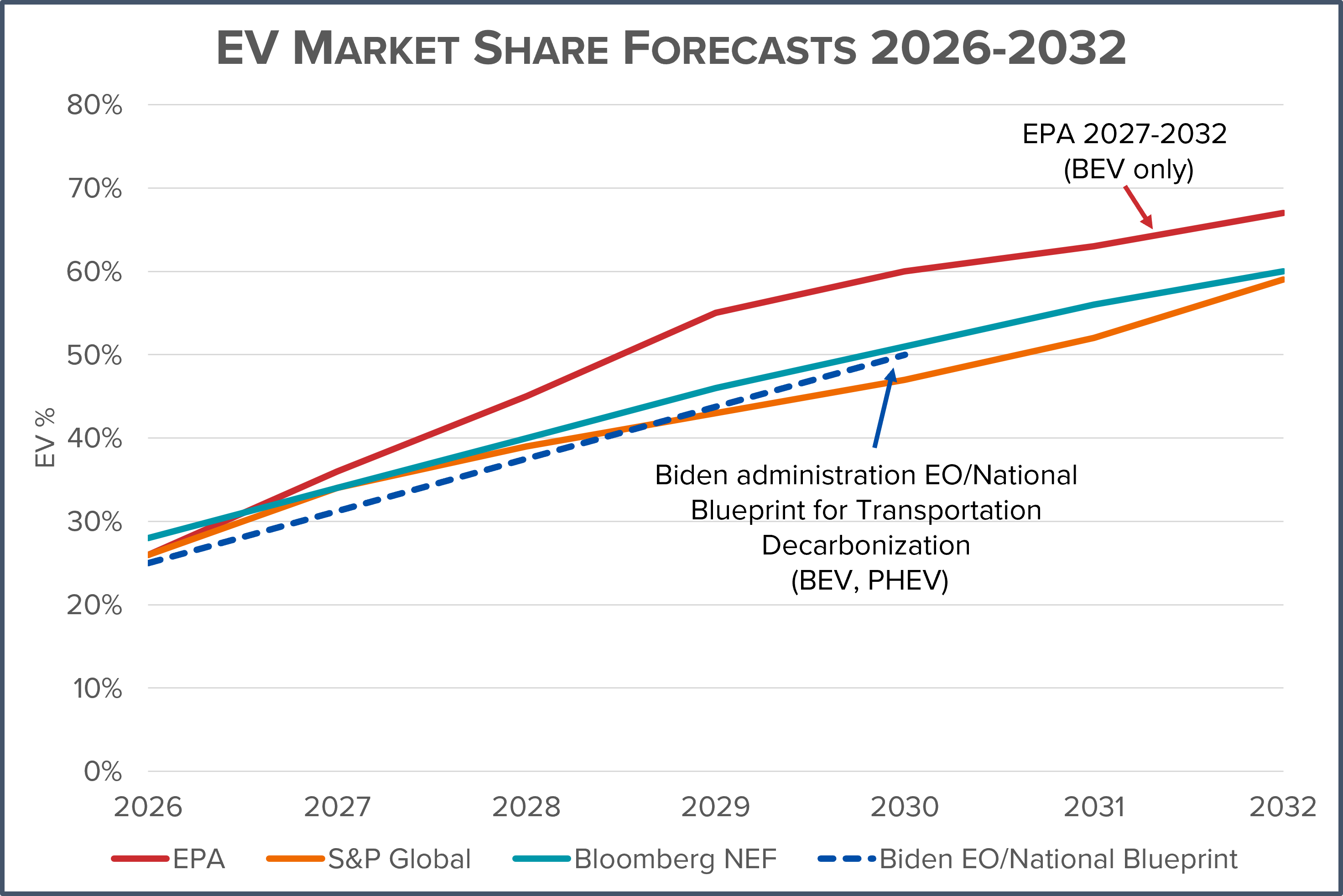By John Bozzella
EPA and the Biden administration moved the goalposts with its proposed greenhouse gas emissions rules for light-duty vehicles covering model years 2027-2032.
Requiring 60+ percent of U.S. vehicles sales to be pure battery electric vehicles (BEVs) by 2030 leapfrogged the administration’s own 2021 executive order that called for 50 percent electric vehicles – including plug-in hybrid and fuel cell EVs – by 2030. More on that below.
That 2021 executive order was a stretch goal (then and now), but the auto industry backed a 40-50 percent EV sales target – presuming the requisite public policies would also be in place.
When the companies that will build the millions of EVs required by these regulations say the pace and balance of EPA’s rules are out of whack – in fact, we told the agency those rules are “neither reasonable nor achievable in the timeframe provided" and opens the door to China – regulators and policymakers should believe them.
It’s not too late to course correct. Here are five ways for EPA to fix the proposed rule while supporting increased automotive electrification and carbon reduction.
1. Don’t write off plug-in hybrids and fuel cell EVs
The current EPA rule calls for 37 percent of new light-duty cars and trucks to be BEVs by 2027 (and the aforementioned 60+ percent by 2030). Keep in mind, BEV sales were just under 6 percent in 2022.
But EPA’s proposal goes further and completely writes off plug-in hybrid electric vehicles (PHEVs). A 67 percent BEV-only approach by 2032 will unquestionably reduce consumer choice and push automakers to non-compliance with such unachievable requirements. The administration’s 50 percent executive order from 2021 included BEVs and PHEVs and fuel cell electric vehicles. Why take PHEV technology off the field?
2. Don’t siphon finite resources from EVs to gas-powered vehicles
EPA’s proposal also sets new rules for criteria pollutants from gas-powered vehicles that are already near zero emissions. A backpack leaf blower produces more ozone-forming pollution in one hour than driving an SUV for 6,000 miles.
But automakers support criteria pollution reductions, most recently in California where we developed a path to reduce particulate matter by 67 percent between 2025 and 2028. EPA should get behind those criteria pollution standards.
That said, EPA’s rule requires automakers to eke out some incremental improvements by installing expensive new technology on all internal combustion engines – a powertrain the administration wants to discourage (and California has already banned for new vehicles sales by 2035).
The point: automakers are investing massive amounts of capital in electrification, but every dollar invested (required to be invested, that is) in internal combustion technology is a dollar not spent on zero carbon technology. And vice versa.
3. Sync up EPA’s rules with yet-to-be-released Corporate Average Fuel Economy (CAFE) standards
A vehicle tailpipe is regulated by three federal agencies and four sets of regulations. One vehicle overseen by competing, overlapping (sometimes conflicting) rules that aren’t coordinated. It’s expensive and complex and frankly why the country and automakers need a single national standard to reduce carbon in transportation through a streamlined regulatory structure.
At the very least, if an automaker complies with EPA’s greenhouse gas emissions rules, they shouldn’t be at risk of violating the Transportation Department’s coming CAFE rules and subject to significant civil penalties (that create no environmental benefit but do levy additional costs on consumers, workers and manufacturers).
4. While you’re at it… sync up the rules and eliminate conflict with state standards too
Let me revise that. A vehicle tailpipe is regulated by three federal agencies and the California Air Resources Board (CARB) using seven sets of regulations. EPA should get with CARB to ensure both programs are on the same wavelength and not creating unnecessary compliance burdens (that deliver no corresponding emissions reduction benefits).
5. Keep score (and keep track) of conditions outside the vehicle
I’m a broken record about policies and conditions outside the vehicle necessary for a successful EV transition: residential and public charging, critical mineral availability and grid capacity. EPA should develop a roadmap and methodically track this data so the country – and all sectors of the economy responsible for the transformation – can collectively assess progress.
EPA should release a public report taking stock of the overall EV market, the mineral and processing supply chain and state of refueling and charging infrastructure. For example: How is the transition going? Is it meeting EPA’s milestones? If not, what’s the fix?
When I raise these points with policymakers, I hear: “Well, things have changed since 2021” and the 50 percent executive order. The implication: EPA’s higher EV targets make sense because EV sales continue to grow. We’re on the right path… they say.
I don’t see it that way, and most experts who’ve been building autos or studying the industry for any length of time don’t either. EPA’s proposal is an outlier when compared to the EV adoption models of S&P, Bloomberg and other analysts. See this chart:

EPA is asking for a huge BEV ramp up in the next few years. On a graph, their model looks like a hockey stick. The pitch of that curve is most aggressive in the next few years when market conditions (consumer acceptance, supply chains, infrastructure) are most speculative.
The administration’s 50 percent goal in 2021 was aspirational, but it was also based on clearly defined climate goals – from the United Nations and the incoming Biden administration (reflected in its 2023 National Blueprint for Transportation Decarbonization). It was built on a foundation of credible assumptions. And data.
The 60+ percent BEVs by 2030 plan, on the other hand, is a house of cards (… a house of cars?). It rolls up rosy forecasts (like EV batteries will eventually cost automakers nothing) and other hopeful assumptions.
The next couple years are make or break. The auto industry is making huge progress on electrification and continued improvements to internal combustion engine technology. Don’t toss it away now.
Let’s come out of this process with a balanced, achievable and durable rule that maintains customer choice and doesn’t blunt America’s EV momentum.
John Bozzella is president and CEO of Alliance for Automotive Innovation.
Alliance for Automotive Innovation’s memo on EPA’s 2027-2032 greenhouse gas emissions and criteria pollutant proposal available here.
